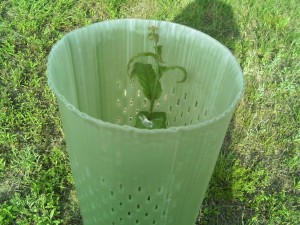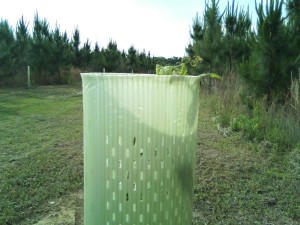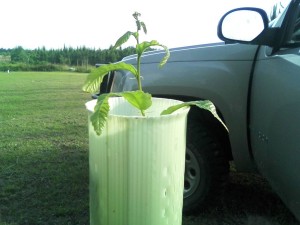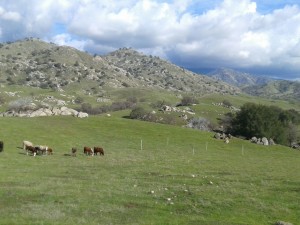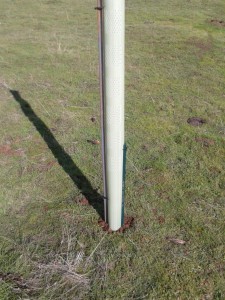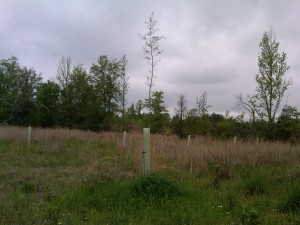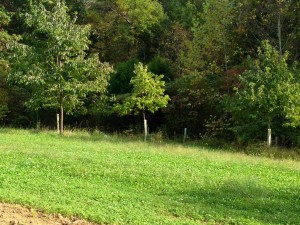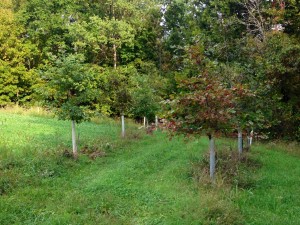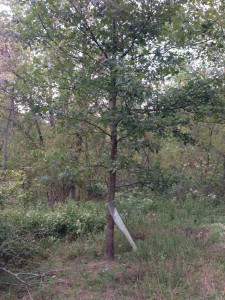It will be out tomorrow!
That’s the text message I got from a customer along with this photo:
Florida panhandle. Sawtooth oak planted as 12″ seedling in mid-March, 2013. Today is May 7, 2013. Tomorrow – and yes it will be tomorrow given that fact it’s now growing more than one inch per day – it will emerge from its 4ft tree tube.
Update: Yes, it did grow out the top today!
Another update, two days later:
California Native Oaks gets a boost
There are many obstacles to re-establishing California’s gorgeous native oaks: Livestock, compacted soils, invasive/exotic grasses and other weed competition, restrictions or impracticality of using fire (an oak’s best friend) as a management tool, and high deer populations, to name a few.
One project is off to a great start, thanks to a dedicated project manager and 5ft and 6ft Tubex Combitube Tree Tubes with t-posts for stakes (and a short steel stake opposite to prevent cattle from spinning the tubes).
OK, This Is Just Craziness!
As of last week this tree – which hasn’t started growing yet this year – was 9ft 8in tall.
It – a hybrid oak seedling – was planted as an 18 inch tall seedling. When was it planted you ask? Get this: November, 2011. How many growing seasons have their been between November, 2011 and April, 2013? One.
Yes, this tree grew 8ft 2in in one growing season! It was started in a 4ft tree tube… which it quickly outgrew. Then a 2ft tree tube extender was added above the 4ft tube… which must have acted like a rocket launcher because the tree shot out the top of that in a hurry. Once the tree grew past the browse line the tube extender was removed (and reused elsewhere).
The thing is, I know there are even faster growing trees out there.
The Rest of the Story in Central Kentucky
Customers often ask: Sure tree tubes speed up growth in year one, but what do the trees look like 4 or 5 years down the line? Is there still a benefit?
The first and most obvious benefit 4 or 5 years down the line is that you actually have a tree, as compared to replanting several times after deer eat your trees.
But a much better – and more visible answer – comes from a customer in Central Kentucky who started using tree tubes nearly ten years ago. Take a look:
Wildlife Habitat Planting, Central Kansas
(Planted spring 2012)
July 17, 2012 email from the customer: Hi Chris, I ordered tree tubes and weed barrier back in April from you. I planted trees all over my pasture and ended up planting 135 oaks and walnuts. I am so glad that I chose to use your tubes and weed barrier as we are in a severe drought and I do not think I would have any left without them… Just wanted to let you know how much I appreciate your advice and help on my first tree planting endeavor!
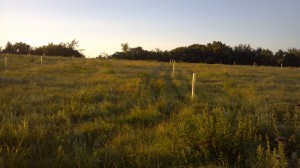
These photos were taken early in the summer, before the drought set in with virtually zero rainfall and temp’s consistently over 100 degrees. During times of drought (which usually correspond with the years you decide to undertake a major tree planting project) tree tubes often mean the difference between success and complete failure. (Click photo to enlarge)
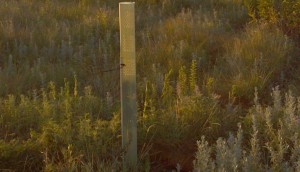
A seedling is working its way up through a Tubex Combitube Tree Tube, safe from deer browse. Tree tubes also shield seedlings from drying winds and full sun, and capture, condense and recharge moisture. The result is outstanding survival even during severe drought. (Click photo to enlarge)
Oak Savannah & Prairie Restoration, Northern Illinois Planted spring, 2012
Emails from the customer: Hi Chris, Just a quick update. I planted Catalpa tree seeds in my house in early March. I transplanted them in the tree tubes in May. I checked the tree tubes today and found them emerging from the tops of the 5 foot tubes! In just 4 months in the middle of a drought! I am sold on your tree tubes!!! Then a month later: By the way, we had a couple of storms recently with 60 to 70 MPH winds and the tubes stood up to it very well.
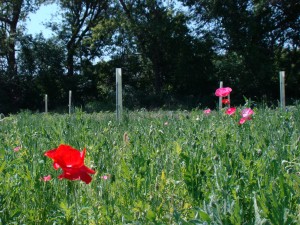
Tree tubes protect native tree seedlings such as oaks, black walnuts and catalpas as part of a prairie and savannah restoration project in Illinois. (Click to enlarge photo)
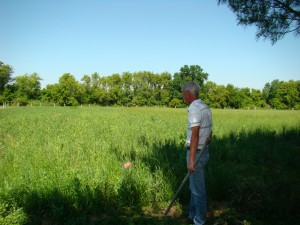
Taking a well-deserved break to look over a successfully restored native prairie and tree planting (the tree tubes are off in the distance across the field). (Click photo to enlarge)

